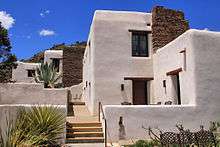Davis Mountains State Park
Davis Mountains State Park is a 2,709-acre (1,096 ha) state park located in the Davis Mountains in Jeff Davis County, Texas. The closest town is Fort Davis, Texas. The park elevation is between 5,000 and 6,000 ft (1,500 and 1,800 m) above sea level. The original portion of the park was deeded to Texas Parks and Wildlife Department by a local family. Original improvements were accomplished by the Civilian Conservation Corps (CCC) in 1933 and the park was opened to the public around 1938. Campground facilities were added in 1967.
| Davis Mountains State Park | |
|---|---|
 The entrance to Davis Mountains State Park in Fort Davis, Texas. | |
 Davis Mountains | |
| Location | Jeff Davis County, Texas, United States |
| Nearest city | Fort Davis |
| Coordinates | 30°35′45″N 103°55′58″W |
| Area | 2,709 acres (1,096 ha) |
| Established | 1938-1939 |
| Governing body | Texas Parks and Wildlife Department |
History
Interest in developing a state park in the Davis Mountains began in earnest in 1923 when the Texas Legislature directed the newly created State Parks Board to investigate the area. However, the Parks Board failed to secure any land donations and had no appropriations to buy the land. By 1933, the Great Depression had so devastated the local economy that landowners agreed to donate 560 acres for the park. CCC Companies 879 and 881 arrived in June 1933 and began organizing their encampment, which they named Camp Washington Seawell, after the first commander of nearby Fort Davis. Their developments in the park included roads, an overlook shelter, two mess halls, stone picnic tables, fireplaces and steps, a latrine and "Indian Lodge."[1]
Features

The park is next to the Fort Davis National Historic Site and the two are connected by four miles of hiking trails. Within the park is the "Indian Lodge", an adobe motel with thirty-nine rooms, sixteen that were built by the Civilian Conservation Corps during the 1930s (completed in 1939) and twenty-four added by Texas Parks and Wildlife in the 1967.[2] A large bird blind next to the main road offers enclosed and open viewing areas for the many species of birds that are attracted to the feeders near the blind.
The park has seven miles of equestrian trails in the special use Limpia Canyon Primitive Area, the section of the park north of Texas State Highway 118.
Flora
Davis Mountains State Park receives more rain than the surrounding desert and hosts a variety of trees such as Mexican pinyon (Pinus cembroides), Emory oak (Quercus emoryi), gray oak (Quercus grisea) and one-seed juniper (Juniperus monosperma). Shrubs such as scarlet bouvardia (Bouvardia ternifolia), little-leaf leadtree (Leucaena retusa), trompillo (Ipomoea hederifolia), evergreen sumac (Rhus virens), fragrant sumac (Rhus aromatica), Apache plume (Fallugia paradoxa), little walnut (Juglans microcarpa), tree cholla (Cylindropuntia imbricata), Torrey yucca (Yucca torreyi), catclaw acacia (Acacia greggii), and agarita (Mahonia trifoliolata) abound. The high elevations 6,000 to 8,360 ft (1,830 to 2,550 m) above sea level, not in the park, boast ponderosa pine (Pinus ponderosa) and quaking aspen (Populus tremuloides).
Fauna
Montezuma quail are regularly observed in the park. Woodhouse's scrub jays, white-winged doves, curve-billed thrashers, white-tailed deer and rock squirrels are among the most common wildlife seen. Collared peccary, cougars and American black bears have also been recorded in the park.
Gallery
- Rock outcropping along the Indian Lodge Trail
- View of Indian Lodge from the Indian Lodge Trail
 Indian Lodge lobby interior
Indian Lodge lobby interior- View of Davis Mountains State Park (Indian Lodge to the far left)
See also
| Wikimedia Commons has media related to Davis Mountains State Park. |
References
- The Look of Nature: Designing Texas State Parks During the Great Depression. Texas Parks and Wildlife Department. Retrieved August 9, 2014.
- "Indian Lodge: History". Texas Parks and Wildlife Department. Retrieved 25 May 2015.